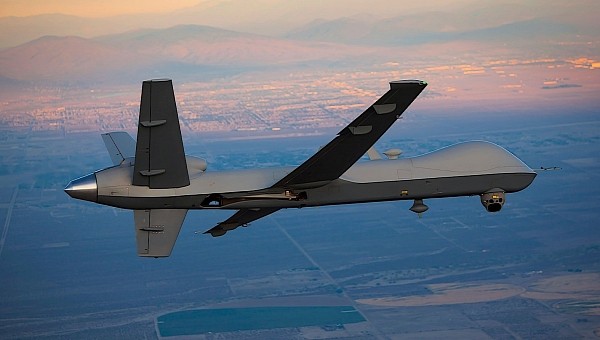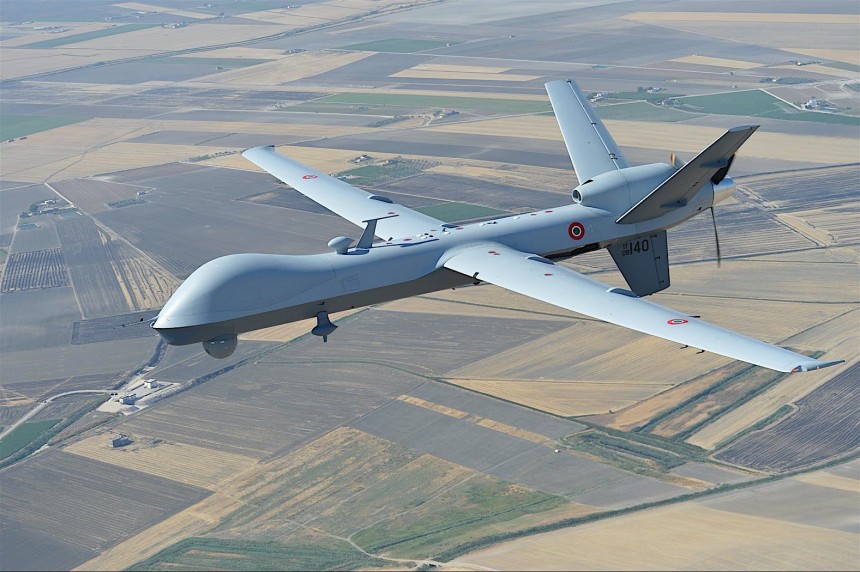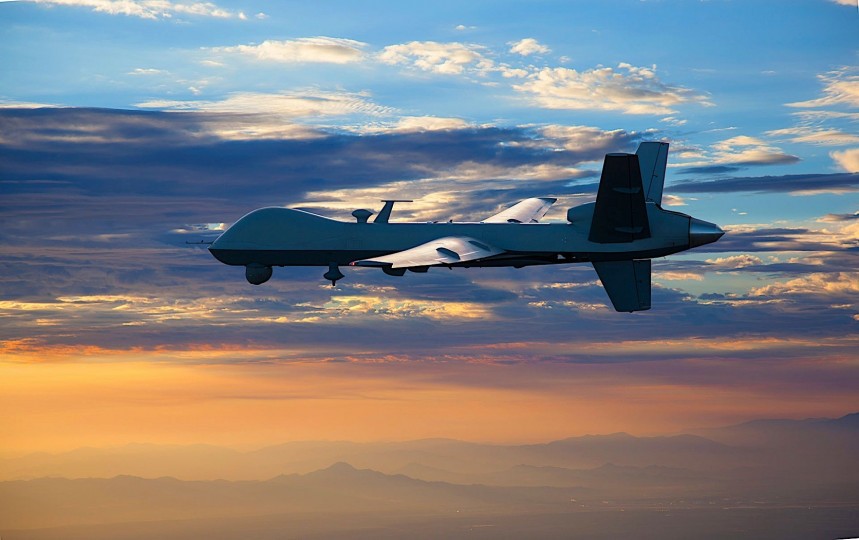For almost as long as there's been aerial warfare, unmanned drones always have had a place on the battlefield. As early as World War I, people were strapping bombs to wooden bi-planes with piston engines and hoping they generally flew near the target. But perhaps never before has a drone been at the forefront of a conflict the way the General Atomics MQ-9 Reaper just became.
At approximately 7:03 a.m. (CET) on April 14th, 2022, two Sukhoi Su-27 twin-engine Russian jet fighters moved to intercept a U.S. Air Force MQ-9 Reaper drone flying over the Black Sea in the vicinity of Ukrainian Air Space. After what U.S. intelligence described as particularly reckless airmanship on the part of the Russians, one of the Sukhoi's allegedly plowed into the MQ-9, turning the drone to paste in the process as it hit the water and very nearly starting an international incident.
Today, let's look at the life of the U.S. Air Force's favorite drone. As you'll find, it was only a matter of time before the thing found itself at the epicenter of a global predicament. Of course, you can't tell the story of the MQ-9 without first talking about the company that builds them, General Atomics(GA). Founded in 1955, GA is one of the most interesting multi-faceted manufacturing operations still operating in the United States.
Based out of San Diego, California, the company specializes in two different but equal manufacturing sectors. These would, of course, be military defense equipment but also nuclear energy research. Be it conventional fusion reactors or more niche fusion experiments, GA has personnel at the forefront of discovery on those fronts. It's actually GA's bespoke aerospace offshoot, General Atomics Aeronautical Systems, that handles the military-drone portion of the business.
GA's first foray into military UAVs came in the form of the Gnat. A roughly 500kg (1102.3 lb) CIA reconnaissance drone powered by a puny air-cooled Rotax 912 boxer engine. Because the engine was at the rear of this plane, it's basically a Porsche 911 with wings. The Gnat cut its teeth flying over Albania and the former Yugoslavia in the 1990s but was promptly usurped by the MQ-9 Reaper's direct predecessor, the MQ-1 Predator.
With dimensions of 27 feet (8.23 meters long with a 48 foot 7 inch (14.8 m) wingspan and weighing in at 2,249 lb (1,020 kg), the Predator took on a silhouette that became the standard shape for General Atomics drones. The Predator flew into battle via a remotely-located three-person crew and could wield weapons like Hellfire and AGM-176 Griffin air-to-ground missiles (AGMs) and AIM-92 Stinger air-to-air missiles (AAMs).
A fascinating individual designed the Predator in his own right. An Iraqi-born Israeli citizen named Abraham Karem moved to the United States in the 1970s with the sole intention of designing fixed-wing drones for the Pentagon. It was Karem's artist hand that created the first rough sketches for what was at first called the Predator B. From the ground up; the MQ-9 was designed to be profoundly more capable than its MQ-1 parent.
This upgrade path starts with the engine. It's a 900-horsepower Honeywell T76 turboprop unit most famous for its use in the civilian Beech King Air leisure plane. The extra turbine grunt from this plucky little engine helps the MQ-9 reach a top speed of 300 mph (482 kph). Not exactly impressive for a manned jet fighter, but pretty fantastic considering how slow the Reaper's forbearers were.
With an internal payload capacity of 800lbs inside the Reaper's weapons bay and a further 3,000 via external underwing pylons, the MQ-9 carries a respectable amount of ordnance for such a diminutive airframe. This includes all of the goodies its forbearer, the MQ-1 Predator, flew into battle alongside new additions like GBU-38 JDAMs, Brimstone AGMs, GBU-12 Paveway Bombs, and, of course, AGM-114 Hellfire AGMs.
As for avionics, an advanced AN/DAS-1 MTS-B Multi-Spectral Targeting System with AN/APY-8 Lynx II radar allows for a reduced crew of two operators over the MQ-1's minimum of three ground operators. With order contracts on the books for the U.S. Air Force, NASA, the U.S. Dept of Homeland Security, and allied Air Forces like France, the U.K., Belgium, Germany, Greece, Italy, and India, the Reaper drone is one of the most versatile UAVs ever flown.
With an estimated unit cost of $32 million a pop, the MQ-9 is no mere child's toy. This means, of course, when the Russian Air Force decided to perform a fuel dump right overtop of a Reaper drone this month, they were messing around with millions in U.S. taxpayer money. At a time when hundreds of thousands of Russian and Ukrainian casualties plague Eastern Europe, these kinds of incidents can very easily lead to a larger conflict that nobody, not even Putin, really wants to trifle with.
But more to the point, it's highly doubtful this avoidable situation will stop further American Reapers from scouring the landscape from just outside Ukrainian territory. Should brazenly reckless interceptions by Russian fighters continue in step with NATO surveillance, it might not be long before MQ-9 Reapers make way for F-18s or F-35s. It's an escalation that's shocking to ponder but one that seems more and more likely lately.
In the mean time, reports from the American Defense Secretary Lloyd Austin seem to indicate Russia might currently be in a mad dash to retreive the fallen Reaper's remains, although this remains unconfirmed. It's just another headache in the Pentagon's side this month.
Today, let's look at the life of the U.S. Air Force's favorite drone. As you'll find, it was only a matter of time before the thing found itself at the epicenter of a global predicament. Of course, you can't tell the story of the MQ-9 without first talking about the company that builds them, General Atomics(GA). Founded in 1955, GA is one of the most interesting multi-faceted manufacturing operations still operating in the United States.
Based out of San Diego, California, the company specializes in two different but equal manufacturing sectors. These would, of course, be military defense equipment but also nuclear energy research. Be it conventional fusion reactors or more niche fusion experiments, GA has personnel at the forefront of discovery on those fronts. It's actually GA's bespoke aerospace offshoot, General Atomics Aeronautical Systems, that handles the military-drone portion of the business.
GA's first foray into military UAVs came in the form of the Gnat. A roughly 500kg (1102.3 lb) CIA reconnaissance drone powered by a puny air-cooled Rotax 912 boxer engine. Because the engine was at the rear of this plane, it's basically a Porsche 911 with wings. The Gnat cut its teeth flying over Albania and the former Yugoslavia in the 1990s but was promptly usurped by the MQ-9 Reaper's direct predecessor, the MQ-1 Predator.
A fascinating individual designed the Predator in his own right. An Iraqi-born Israeli citizen named Abraham Karem moved to the United States in the 1970s with the sole intention of designing fixed-wing drones for the Pentagon. It was Karem's artist hand that created the first rough sketches for what was at first called the Predator B. From the ground up; the MQ-9 was designed to be profoundly more capable than its MQ-1 parent.
This upgrade path starts with the engine. It's a 900-horsepower Honeywell T76 turboprop unit most famous for its use in the civilian Beech King Air leisure plane. The extra turbine grunt from this plucky little engine helps the MQ-9 reach a top speed of 300 mph (482 kph). Not exactly impressive for a manned jet fighter, but pretty fantastic considering how slow the Reaper's forbearers were.
With an internal payload capacity of 800lbs inside the Reaper's weapons bay and a further 3,000 via external underwing pylons, the MQ-9 carries a respectable amount of ordnance for such a diminutive airframe. This includes all of the goodies its forbearer, the MQ-1 Predator, flew into battle alongside new additions like GBU-38 JDAMs, Brimstone AGMs, GBU-12 Paveway Bombs, and, of course, AGM-114 Hellfire AGMs.
With an estimated unit cost of $32 million a pop, the MQ-9 is no mere child's toy. This means, of course, when the Russian Air Force decided to perform a fuel dump right overtop of a Reaper drone this month, they were messing around with millions in U.S. taxpayer money. At a time when hundreds of thousands of Russian and Ukrainian casualties plague Eastern Europe, these kinds of incidents can very easily lead to a larger conflict that nobody, not even Putin, really wants to trifle with.
But more to the point, it's highly doubtful this avoidable situation will stop further American Reapers from scouring the landscape from just outside Ukrainian territory. Should brazenly reckless interceptions by Russian fighters continue in step with NATO surveillance, it might not be long before MQ-9 Reapers make way for F-18s or F-35s. It's an escalation that's shocking to ponder but one that seems more and more likely lately.
In the mean time, reports from the American Defense Secretary Lloyd Austin seem to indicate Russia might currently be in a mad dash to retreive the fallen Reaper's remains, although this remains unconfirmed. It's just another headache in the Pentagon's side this month.















